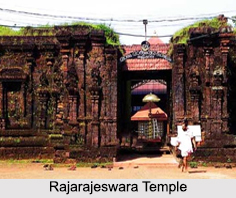 The Rajarajeswara Temple is an ancient early medieval temple in South India which carried its pride in Chola art and architecture. This temple is dedicated to Lord Shiva and is located at Taliparamba in the Kannur district of the Indian state of Kerala. The temple has some similarities with the Taliparamba Temple of Kerala.
The Rajarajeswara Temple is an ancient early medieval temple in South India which carried its pride in Chola art and architecture. This temple is dedicated to Lord Shiva and is located at Taliparamba in the Kannur district of the Indian state of Kerala. The temple has some similarities with the Taliparamba Temple of Kerala.
Legend of Rajarajeswara Temple
As per legends, the Rajarajeswara Temple was supposedly renovated by Sage Parashurama, long before the Kali Yuga commenced. Several centuries ago it was renovated by the Mushika dynasty kings. Later, the Rajarajeswara Temple was rebuilt into its present form in the early 11th century, during the Chola rule. The quadrangular sanctum has a two- tiered pyramidal roof; in front of the sanctum is the namaskara mandapam, but the temple has no kodi maram or flagstaff, unlike others in Kerala. This temple is regarded as one of the ancient Shakti Peethas. The mythology confirms that the head of Sati, wife of Lord Shiva, fell here after Shiva`s tandavam.
History of Rajarajeswara Temple
The recorded history of the temple shows that the Rajarajeswara Temple had two ancient large seven storied Gopurams, whose relics in the form of debris can be still seen today lying around the Eastern and Western entrances. These gopurams are said to be destroyed by Tipu Sultan in the late 18th century. Even today, the debris reveals how grand these edifices were before their destruction and had intricate sculptures, some of which can still be seen. It is believed that a snake bit the commander of the army who was about to destroy the temple, and following this, the temple was spared from destruction.
Mythological History of Rajarajeswara Temple
The Shiva Lingam here is believed to be several thousands of years old. Maandhata is one of the ancient Indian sages of propitiated Lord Shiva. Shiva was so pleased that he presented one of the Shiva Lingams to him with the injunction that it should be installed only at a place where there was no cremation ground. The sage, after searching all over, found Taliparamba the most sacred spot where he installed the Shiva Lingam. After his death the Shiva Lingam disappeared into the earth. Then his son Muchukunda offered similar prayers to Lord Shiva or Mahadeva and got a second Shiva Lingam, which too disappeared in course of time.
The third Shiva Lingam was handed down to "Satasoman", a king of Chirakkal royal family, who then ruled the region. He was an ardent devotee of Lord Shiva. On the advice of sage Agastya, he prayed to Lord Shiva, who granted him the Shiva Lingam. The king installed it in the present temple built by him. However, many legends are associated with the Rajarajeswara temple. It is claimed that Agastya himself installed the Shiva Lingam. It is also believed that Lord Rama in Indian epic Ramayana, during his victorious return from Lanka stopped here to offer worship to Lord Shiva. In honour of His presence, devotees are not allowed into the namaskara mandapam even today.
Architecture of Rajarajeswara Temple
During the Chola Period, the Rajarajeswara Temple had the tallest "shikhara" amongst the temples of its time. Rajarajeshwara Temple has a top of about 90 tonnes. On entering the eastern gate of the temple, the devotee circumambulates the whole central shrine before stepping inside. Towards the northern side there is a small shrine of a guardian deity called Yakshi. Usually a Yakshi is considered to be a female spirit with malevolent propensities, but the Yakshi installed here represents a prosperity-giving and benevolent spiritual power. The figure of Yakshi is a life-size wooden sculpture of unique charm. The Yakshi is represented as looking intently into a mirror. After worshiping this guardian deity, the devotees proceed towards the front of the central shrine and worship the mount of Lord Shiva, Lord Rishabha, the bull, outside the central shrine facing Lord Shiva. Near Rishabha is the Balikkallu of huge proportions, made out of granite with many figurines and intricate carvings.
Customs in Rajarajeswara Temple
It is a custom that only men enter the Naalambalam during the daytime in the main courtyard of Rajarajeswara Temple, while women stand outside. The women can enter the Naalambalm all days after the Athazha puja is over in the evening. It is assumed that after Athazha puja the lord is in an aspect of a very pleased and cordial temperament accompanied by Goddess Parvati. The Rajarajeswara Temple is considered as most sacred for performing the art forms of Koodiyattam and Chakyar Koothu.
Visiting Information on Rajarajeswara Temple
The nearest railway station is at Kannur at a distance of 24 km and the Kannur International Airport is about 37 km away from the temple. After reaching the city of Talimparamba, one can reach the temple via roadways from the bus stand of Talimparamba, which is at a mere distance of 1.5 km.











